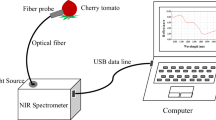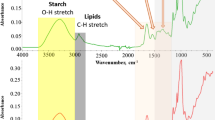Abstract
Organic products or products with a protected designation of origin (PDO) are vulnerable to fraud; therefore, new and cheaper analytical tools are needed to authenticate them. This work aimed to evaluate the feasibility of using a low-cost and easy-to-use near-infrared (NIR) spectrometer to discriminate agronomic practices and the geographic origin of tomatoes and sweet peppers from different Brazilian regions. Different chemometric approaches were applied, such as principal components analysis (PCA), data driven-soft independent modeling of class analogy (DD-SIMCA), and partial least squares-discriminant analysis (PLS-DA). PCA did not allow clear differentiation between the classes, while the PLS-DA showed excellent classification, with prediction accuracy between 61.9 and 100%. Furthermore, the DD-SIMCA proved to be a good tool for verifying the authenticity of organic tomatoes and sweet peppers, with an accuracy of over 82.7%. These results suggest that the NIR technique combined with chemometrics can be an excellent technique to verify the authenticity of tomatoes and sweet peppers according to the agronomic mode of production and the geographical origin of products by the non-volatile profile using equipment that can be easily set up and acquired at a lower cost.
Graphical Abstract








Similar content being viewed by others
Data Availability
The authors declare that all other data supporting the fndings of this study are available within the article and its supplementary information files.
References
Barba OI, Cámara Hurtado M, Sánchez Mata MC et al (2006) Application of a UV-vis detection-HPLC method for a rapid determination of lycopene and β-carotene in vegetables. Food Chem 95:328–336. https://doi.org/10.1016/j.foodchem.2005.02.028
Bishop CM (2006) Pattern recognition and machine learning. Springer, New York, NY, New York
Borghi FT, Santos PC, Santos FD, et al (2020) Quantification and classification of vegetable oils in extra virgin olive oil samples using a portable near-infrared spectrometer associated with chemometrics. Microchem J 159. https://doi.org/10.1016/j.microc.2020.105544
Brasil YL, Cruz-Tirado JP, Barbin DF (2022) Fast online estimation of quail eggs freshness using portable NIR spectrometer and machine learning. Food Control 131:108418. https://doi.org/10.1016/j.foodcont.2021.108418
Brito A, Campos F, dos Reis Nascimento A, et al (2022) Non-destructive determination of color, titratable acidity, and dry matter in intact tomatoes using a portable Vis-NIR spectrometer. J Food Compos Anal 107.https://doi.org/10.1016/j.jfca.2021.104288
Büning-Pfaue H (2003) Analysis of water in food by near infrared spectroscopy. Food Chem 82:107–115. https://doi.org/10.1016/S0308-8146(02)00583-6
Castrignanò A, Buttafuoco G, Malegori C et al (2019) Assessing the feasibility of a miniaturized near-infrared spectrometer in determining quality attributes of San Marzano tomato. Food Anal Methods 12:1497–1510. https://doi.org/10.1007/s12161-019-01475-x
Ciza PH, Sacre PY, Waffo C et al (2019) Comparing the qualitative performances of handheld NIR and Raman spectrophotometers for the detection of falsified pharmaceutical products. Talanta 202:469–478. https://doi.org/10.1016/j.talanta.2019.04.049
Consonni R, Polla D, Cagliani LR (2018) Organic and conventional coffee differentiation by NMR spectroscopy. Food Control 94:284–288. https://doi.org/10.1016/j.foodcont.2018.07.013
Cuq S, Lemetter V, Kleiber D, Levasseur-Garcia C (2020) Assessing macro- (P, K, Ca, Mg) and micronutrient (Mn, Fe, Cu, Zn, B) concentration in vine leaves and grape berries of vitis vinifera by using near-infrared spectroscopy and chemometrics. Comput Electron Agric 179. https://doi.org/10.1016/j.compag.2020.105841
Silva R, De Menezes MGG, De Castro RC et al (2019) Efficiency of ESI and APCI ionization sources in LC-MS/MS systems for analysis of 22 pesticide residues in food matrix. Food Chem 297:124934. https://doi.org/10.1016/j.foodchem.2019.06.001
Ding X, Ni Y, Kokot S (2015) NIR spectroscopy and chemometrics for the discrimination of pure, powdered, purple sweet potatoes and their samples adulterated with the white sweet potato flour. Chemom Intell Lab Syst 144:17–23. https://doi.org/10.1016/j.chemolab.2015.03.004
Durán-Lara EF, Valderrama A, Marican A (2020) Natural organic compounds for application in organic farming. Agric 10:1–22. https://doi.org/10.3390/agriculture10020041
EEC (2011) EEC 1169/2011. Official Journal of the European Union, 1st edn. European Parliament and of the Council, Commission Directives, pp 25–32
Faith Ndlovu P, Samukelo Magwaza L, Zeray Tesfay S, Ramaesele Mphahlele R (2022) Destructive and rapid non-invasive methods used to detect adulteration of dried powdered horticultural products: a review. Food Res Int 157:111198. https://doi.org/10.1016/j.foodres.2022.111198
Ferreira JA, Ferreira JMS, Talamini V et al (2016) Determination of pesticides in coconut (Cocos nucifera Linn.) water and pulp using modified QuEChERS and LC–MS/MS. Food Chem 213:616–624. https://doi.org/10.1016/j.foodchem.2016.06.114
Galvan D, Tanamati AAC, Casanova F et al (2021) Compact low-field NMR spectroscopy and chemometrics applied to the analysis of edible oils. Food Chem 365:130476. https://doi.org/10.1016/j.foodchem.2021.130476
Galvan D, Lelis CA, Effting L et al (2022) Low-cost spectroscopic devices with multivariate analysis applied to milk authenticity. Microchem J J 181:107746. https://doi.org/10.1016/j.microc.2022.107746
Galvan D, de Andrade JC, Effting L et al (2023) Energy-dispersive X-ray fluorescence combined with chemometric tools applied to tomato and sweet pepper classification. Food Control 143:109326. https://doi.org/10.1016/j.foodcont.2022.109326
Guilherme R, Rodrigues N, Marx ÍMG et al (2020) Sweet peppers discrimination according to agronomic production mode and maturation stage using a chemical-sensory approach and an electronic tongue. Microchem J 157:105034. https://doi.org/10.1016/j.microc.2020.105034
Hohmann M, Monakhova Y, Erich S et al (2015) Differentiation of organically and conventionally grown tomatoes by chemometric analysis of combined data from proton nuclear magnetic resonance and mid-infrared spectroscopy and stable isotope analysis. J Agric Food Chem 63:9666–9675. https://doi.org/10.1021/acs.jafc.5b03853
Jong S (1993) SIMPLS : an alternative approach to partial least squares regression. Chemom Intell Lab Syst 18:251–263
Lelis CA, Galvan D, Tessaro L et al (2022) Fluorescence spectroscopy in tandem with chemometric tools applied to milk quality control. J Food Compos Anal 109:104515. https://doi.org/10.1016/j.jfca.2022.104515
Luna AS, da Silva AP, da Silva CS et al (2019) Chemometric methods for classification of clonal varieties of green coffee using Raman spectroscopy and direct sample analysis. J Food Compos Anal 76:44–50. https://doi.org/10.1016/j.jfca.2018.12.001
Malegori C, Oliveri P (2018) Principal component analysis. In: Hyperspectral imaging analysis and applications for food quality. CRC Press, New York, 23
Mallet A, Charnier C, Latrille É et al (2021) Unveiling non-linear water effects in near infrared spectroscopy: a study on organic wastes during drying using chemometrics. Waste Manag 122:36–48. https://doi.org/10.1016/j.wasman.2020.12.019
MAPA (2009) 2009, nstrução Normativa Conjunta No 18 de 28 de Maio de. MAPA, Brazil
Marseglia A, Acquotti D, Consonni R et al (2016) HR MAS 1H NMR and chemometrics as useful tool to assess the geographical origin of cocoa beans - comparison with HR 1H NMR. Food Res Int 85:273–281. https://doi.org/10.1016/j.foodres.2016.05.001
McFadden BR, Bovay J, Mullally C (2021) What are the overall implications of rising demand for organic fruits and vegetables? Evidence from theory and simulations. Q Open 1:1–24. https://doi.org/10.1093/qopen/qoab008
McVey C, McGrath TF, Haughey SA, Elliott CT (2021) A rapid food chain approach for authenticity screening: the development, validation and transferability of a chemometric model using two handheld near infrared spectroscopy (NIRS) devices. Talanta 222:121533. https://doi.org/10.1016/j.talanta.2020.121533
Michaliszyn-Gabryś B, Krupanek J, Kalisz M, Smith J (2022) Challenges for sustainability in packaging of fresh vegetables in organic farming. Sustain 14:1–29. https://doi.org/10.3390/su14095346
Oliveri P, Malegori C, Mustorgi E, Casale M (2021) Qualitative pattern recognition in chemistry: theoretical background and practical guidelines. Microchem J 162:105725. https://doi.org/10.1016/j.microc.2020.105725
Panebianco S, Mazzoleni P, Barone G et al (2022) Feasibility study of tomato fruit characterization by fast XRF analysis for quality assessment and food traceability. Food Chem 383:132364. https://doi.org/10.1016/j.foodchem.2022.132364
Pasquini C (2018) Near infrared spectroscopy: a mature analytical technique with new perspectives – A review. Anal Chim Acta 1026:8–36. https://doi.org/10.1016/j.aca.2018.04.004
Petropoulos SA, Fernandes Â, Katsoulas N et al (2019) The effect of covering material on the yield, quality and chemical composition of greenhouse-grown tomato fruit. J Sci Food Agric 99:3057–3068. https://doi.org/10.1002/jsfa.9519
Radulescu C, Olteanu RL, Nicolescu CM, et al (2021) Vibrational spectroscopy combined with chemometrics as tool for discriminating organic vs. conventional culture systems for red grape extracts. Foods 10. 10.3390/foods10081856
Rodionova OY, Oliveri P, Pomerantsev AL (2016) Rigorous and compliant approaches to one-class classification. Chemom Intell Lab Syst 159:89–96. https://doi.org/10.1016/j.chemolab.2016.10.002
Rodionova OY, Titova AV, Pomerantsev AL (2016) Discriminant analysis is an inappropriate method of authentication. TrAC - Trends Anal Chem 78:17–22. https://doi.org/10.1016/j.trac.2016.01.010
Sârbu C, Nacu-Briciu RD, Kot-Wasik A et al (2012) Classification and fingerprinting of kiwi and pomelo fruits by multivariate analysis of chromatographic and spectroscopic data. Food Chem 130:994–1002. https://doi.org/10.1016/j.foodchem.2011.07.120
Skolik P, Morais CLM, Martin FL, McAinsh MR (2019) Determination of developmental and ripening stages of whole tomato fruit using portable infrared spectroscopy and Chemometrics. BMC Plant Biol 19:1–15. https://doi.org/10.1186/s12870-019-1852-5
Sousa C, Quintelas C, Augusto C et al (2019) Discrimination of Camellia japonica cultivars and chemometric models: an interlaboratory study. Comput Electron Agric 159:28–33. https://doi.org/10.1016/j.compag.2019.02.025
Talari ACS, Martinez MAG, Movasaghi Z et al (2017) Advances in Fourier transform infrared (FTIR) spectroscopy of biological tissues. Appl Spectrosc Rev 52:456–506. https://doi.org/10.1080/05704928.2016.1230863
Vieira TF, Makimori GYF, dos Santos Scholz MB et al (2020) Chemometric approach using ComDim and PLS-DA for discrimination and classification of commercial yerba mate (Ilex paraguariensis St. Hil.). Food Anal Methods 13:97–107. https://doi.org/10.1007/s12161-019-01520-9
Wernecke R, Wernecke J (2013) Industrial moisture and humidity measurement: a practical guide
Westad F, Marini F (2015) Validation of chemometric models - a tutorial. Anal Chim Acta 893:14–24. https://doi.org/10.1016/j.aca.2015.06.056
Zhang J, Yang R, Chen R et al (2019) Geographical origin discrimination of pepper (Capsicum annuum L.) based on multi-elemental concentrations combined with chemometrics. Food Sci Biotechnol 28:1627–1635. https://doi.org/10.1007/s10068-019-00619-3
Zontov YV, Rodionova OY, Kucheryavskiy SV, Pomerantsev AL (2017) DD-SIMCA – A MATLAB GUI tool for data driven SIMCA approach. Chemom Intell Lab Syst 167:23–28. https://doi.org/10.1016/j.chemolab.2017.05.010
Acknowledgements
The authors are thankful to the Laboratório de Aplicações de Raios X from UEL for the support in the measurements and to Professor Mário Henrique M. Killner – UEL for assisting with the NIR analyses.
Funding
The current study was funded by the Fundação de Amparo à Pesquisa do Estado do Rio de Janeiro (FAPERJ) Brazil—grant number [E-26/200.891/2021, E-26/200.721/2021, and E-26/200.358/2021], Federal University of Mato Grosso do Sul (UFMS)/Fundação de Apoio ao Desenvolvimento do Ensino, Ciência, e Tecnologia de Mato Grosso do Sul (Fundect/MS)—grant number [23104.016018/2022–84], the Conselho Nacional de Desenvolvimento Científico e Tecnológico (CNPq)—grant number [313119/2020–1, 163480/2020–6, 312595/2021–2, and 310446/2020–1], INCT-FNA [464898/2014–5], and the Coordenação de Aperfeiçoamento de Pessoal de Nível Superior (CAPES) Brazil–Finance Code001.
Author information
Authors and Affiliations
Contributions
Jelmir Craveiro de Andrade: conceptualization, investigation, data curation, methodology, software, writing—original draft, visualization, writing—review and editing. Diego Galvan: investigation, data curation, methodology, writing—original draft, visualization, writing—review and editing. Luciane Effting: conceptualization, data curation, methodology, visualization, writing—review and editing. Carini Aparecida Lelis: writing—original draft, visualization, writing—review and editing. Fábio Luiz Melquiades: investigation, data curation, methodology, software, visualization, writing—review and editing, supervision, writing, writing—review and editing. Evandro Bona: investigation, data curation, methodology, software, visualization, writing—review and editing, supervision, writing, writing—review and editing. Carlos Adam Conte-Junior: funding acquisition, project administration, visualization, supervision, writing—review and editing.
Corresponding author
Ethics declarations
Ethics Approval
This article does not contain any studies with humans or animals.
Consent to Participate
Not applicable.
Conflict of Interest
Jelmir Craveiro de Andrade declares that he has no conflict of interest. Diego Galvan declares that he has no conflict of interest. Luciane Effting declares that she has no conflict of interest. Carini Aparecida Lelis declares that she has no conflict of interest. Fábio Melquiades declares that he has no conflict of interest. Evandro Bona declares that he has no conflict of interest. Carlos Adam Conte Junior declares that he has no conflict of interest.
Additional information
Publisher's Note
Springer Nature remains neutral with regard to jurisdictional claims in published maps and institutional affiliations.
Supplementary Information
Below is the link to the electronic supplementary material.
Rights and permissions
Springer Nature or its licensor (e.g. a society or other partner) holds exclusive rights to this article under a publishing agreement with the author(s) or other rightsholder(s); author self-archiving of the accepted manuscript version of this article is solely governed by the terms of such publishing agreement and applicable law.
About this article
Cite this article
de Andrade, J.C., Galvan, D., Effting, L. et al. An Easy-to-Use and Cheap Analytical Approach Based on NIR and Chemometrics for Tomato and Sweet Pepper Authentication by Non-volatile Profile. Food Anal. Methods 16, 567–580 (2023). https://doi.org/10.1007/s12161-022-02439-4
Received:
Accepted:
Published:
Issue Date:
DOI: https://doi.org/10.1007/s12161-022-02439-4




